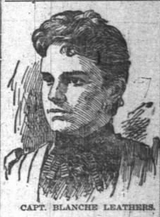
Natchez is the only city in and the county seat of Adams County, Mississippi, United States. It has a total population of 14,520. Located on the Mississippi River across from Vidalia in Concordia Parish, Louisiana, Natchez was a prominent city in the antebellum years, a center of cotton planters and Mississippi River trade.

A steamboat is a boat that is propelled primarily by steam power, typically driving propellers or paddlewheels. Steamboats sometimes use the prefix designation SS, S.S. or S/S or PS ; however, these designations are most often used for steamships.

The 1894 LSU football team represented Louisiana State University (LSU) during the 1894 college football season. The Tigers adopted a new coach, Albert Simmonds, for the three-game 1894 season. This season marked LSU's first ever victory with the 26–0 win over Natchez Athletic Club. The team's captain, Samuel Marmaduke Dinwidie Clark, became the first LSU player to ever score a touchdown during the game against Natchez A.C. The first football game played on the LSU campus was on December 3, 1894, against Mississippi. LSU's only touchdown in that game was scored by the head coach, Albert Simmonds. This was the first year of play for William S. Slaughter, who lettered as an end for five years, from 1894 to 1898. Slaughter was LSU's first five-time football letterman.
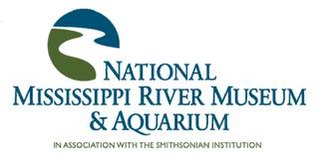
The National Mississippi River Museum & Aquarium is a museum located in Dubuque, Iowa, USA. The museum is a property of the Dubuque County Historical Society, which also operates the Mathias Ham Historic Site. The museum has two buildings on its riverfront campus: the Mississippi River Center and the National River Center. The museum originally opened as the Fred W. Woodward Riverboat Museum on July 18, 1982 before being expanded and re-organized into its current form.

Natchez has been the name of several steamboats, and four naval vessels, each named after the city of Natchez, Mississippi or the Natchez people. The current one has been in operation since 1975. The previous Natchez were all operated in the nineteenth century, most by Captain Thomas P. Leathers. Each of the steamboats since Leathers' first had as its ensign a cotton bale between its stacks.

The steamboat Enterprise demonstrated for the first time by her epic 2,200-mile (3,500 km) voyage from New Orleans to Brownsville, Pennsylvania that steamboat commerce was practical on the Mississippi River and its tributaries.

Robert E. Lee, nicknamed the "Monarch of the Mississippi," was a steamboat built in New Albany, Indiana, in 1866. The hull was designed by DeWitt Hill, and the riverboat cost more than $200,000 to build. She was named for General Robert E. Lee, General in Chief of the Armies of the Confederate States. The steamboat gained its greatest fame for racing and beating the then-current speed record holder, Natchez, in an 1870 steamboat race.

New Orleans was the first steamboat on the western waters of the United States. Owned by Robert Fulton and Robert R. Livingston, and built by Nicholas Roosevelt, its 1811–1812 voyage from Pittsburgh, Pennsylvania, to New Orleans, Louisiana, on the Ohio and Mississippi rivers ushered in the era of commercial steamboat navigation on the western and mid-western continental rivers.
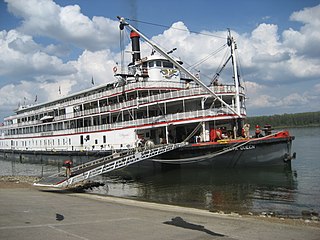
Steamboats played a major role in the 19th-century development of the Mississippi River and its tributaries, allowing practical large-scale transport of passengers and freight both up- and down-river. Using steam power, riverboats were developed during that time which could navigate in shallow waters as well as upriver against strong currents. After the development of railroads, passenger traffic gradually switched to this faster form of transportation, but steamboats continued to serve Mississippi River commerce into the early 20th century. A small number of steamboats are still used for tourist excursions in the 21st century.

Mary Millicent Miller was an American steamboat master who was the first American woman to acquire a steamboat master's license.
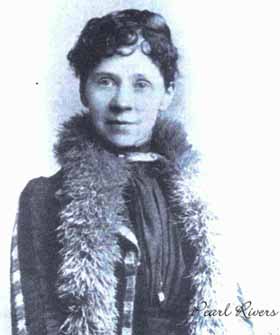
Pearl Rivers was an American journalist and poet, and the first female editor of a major American newspaper. After being the literary editor of the New Orleans Times Picayune, Rivers became the owner and publisher in 1876 when her elderly husband died. In 1880, she took over as managing editor, where she continued until her death in 1896.

The steamer Chautauqua Belle is an authentic Mississippi River-style sternwheel steamboat owned and operated by U.S. Steam Lines Ltd, operating on Chautauqua Lake in Western New York.
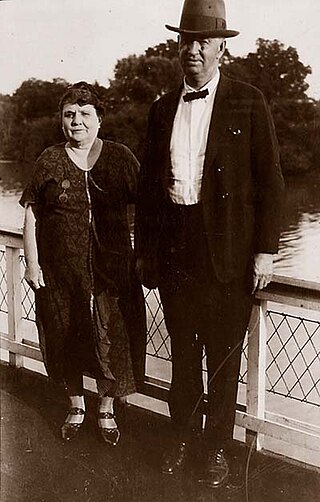
Captain Mary Becker Greene, was steamboat captain of the Greene Line of river steamboats. She was the only female steamboat captain in Ohio.

Callie M. Leach French was an American steamboat captain and pilot. For much of her career as a captain, she worked with her husband, towing showboats along the Ohio, Monogahela and Mississippi Rivers. She played the calliope, cooked, sewed, and wrote jokes for the showboat theater. She never had an accident in her career and was the first woman to hold a masters and pilot's license for a steamboat.

Minnie Mae Mossman Hill was an American steamboat captain. Hill was the first woman to hold a captain's license on the Columbia River. She commanded her own vessels and traded along the river during her career.

Hattie Virginia Feger was an American educator. She was on the faculty of Clark Atlanta University in the 1930s and 1940s.

The Joseph Pulitzer was a 19th-century Sandy Hook pilot boat, built by Moses Adams in 1894 at Essex, Massachusetts for New York Pilots. She was a replacement for the Pilot Boat Edward Cooper, that sank off Sandy Hook in 1892. The Joseph Pulitzer was one of the finest and best equipped boats in the service. She was named in honor of Joseph Pulitzer, a New York newspaper publisher. In 1896, when New York pilot boats were moving to steamboats, she was sold to the Oregon Pilots Association.

The Jesse Carll was a 19th-century pilot boat, built in 1885 by Jesse Carll at Northport, New York, for George H. Sisco. She was one of the largest vessels ever built in the Sandy Hook service. She was named in honor of Jesse Carll, a well-known Northport shipbuilder. In 1896, in the age of steam, the Ezra Nye, along with other pilot boats, were replaced with steamboats.

The Friend was a 19th-century pilot boat built by Daniel D. Kelley & Holmes East Boston shipyard in 1848 for Boston pilots. She helped transport Boston maritime pilots between inbound or outbound ships coming into the Boston Harbor. The Friend was one of the last of the low sided, straight sheared schooners built in the 1840s for Boston pilots. The second Boston pilot boat Friend was built in 1887. Her name came from the older Friend that was in the service in the late 1840s. Captain Thomas Cooper sold the Friend to New York pilots in 1893. Cooper replaced the Friend with the pilot-boat Columbia in 1894.
